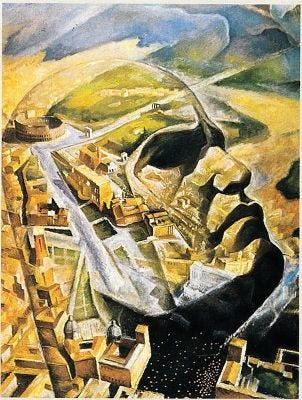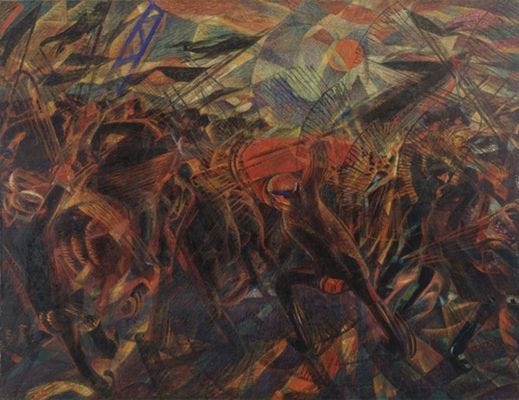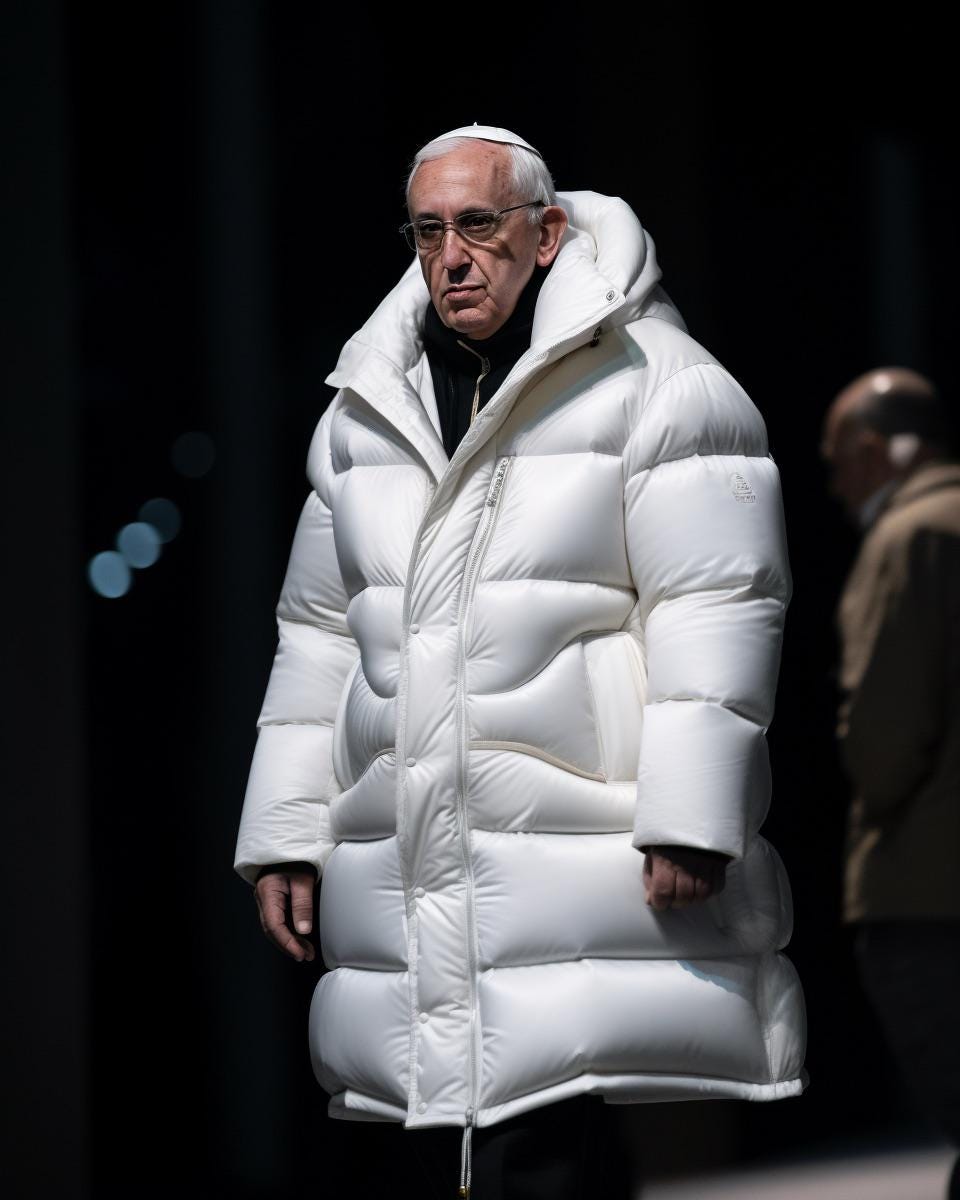There are lots of words that can be used to describe the rise of fascism in the US right now and none of them are ‘unprecedented’. Last fall I read Christopher Ishwerwood’s Goodbye to Berlin (the book that the musical Cabaret is based on) and was struck by how similarly the trajectory of Weimar Germany into Nazism was to brat summer into Fascism winter. The parallels between Trump’s current administration and Hitler’s Third Reich are plentiful and heavily discussed: the anti-trans, anti-immigrant, nationalist stances this administration has already taken make it hard to ignore. Especially since this presidential term began with Elon Musk doing a Nazi salute at Trump’s inauguration.
These parallels are correct and of course important to talk about, but I’ve been thinking alot about the similarities to another fascist movement, slightly west of Germany: Mussolini’s Italy. Mussolini was the person who coined the term ‘fascism’ before starting the Fascist Party in 1921, which would eventually go on to inspire many of Hitler’s political views.
I want to talk specifically about the artistic movements of the Italian Fascist regime. It feels counterintuitive to think about the art that represents and corresponds with fascism, since fascism is historically anti-art - just look at how much art and literature was destroyed under the Nazis - but fascism, just like every belief system, has aesthetic inclinations.
One of the most famous art movements associated with fascism is Italian Futurism, which rose to popularity in the early 20th century. Mussolini refused to label Futurism as the official art of the fascist party, but the Futurist Party and Fascist Party came up around the same time and eventually merged into one party - many of the movement's members ended up working in Mussolini’s administration, including Filippo Tomaso Marinetti, the founder of Futurism and co-writer of the Fascist Manifesto.
Marinetti was the key figure of Futurism and did quite a bit of manifesto writing during his time, including the Futurist Manifesto that laid out the movement’s beliefs. Let’s take a quick look at what he said in that manifesto, which is sort of the backbone of the movement:
“We will glorify war—the world's only hygiene—militarism, patriotism, the destructive gesture of freedom-bringers, beautiful ideas worth dying for, and scorn for women.”
I think it’s important to focus on Marinetti’s own admission that patriotism is linked to destruction, especially considering Trump’s tendency to call his most violent followers patriots - see: the Jan 6 terrorists. This quote sounds like a more eloquent and intelligent version of what Trump is saying every day - his enthusiasm towards the destruction of Gaza and the lives of immigrants in the US, his violent misogyny, his obsession with “America first” is all echoed in this one short statement.
In addition to violence, Futurism glorifies technology, speed, and industry. It was about (excuse this obvious statement) a single minded focus on the future. Marinetti’s idealized future was one where Italy was unburdened by the cultural institutions of its past - namely libraries and museums - as they plowed forward into a violent, masculine new future regardless of the cost.
It seems to me that the current brand of American fascism has quite a bit in common with Italian Futurism - primarily the obsession with technology, speed, and disruption. These values echo the ethos of America’s tech industry, which has become a powerful political player in the past few decades. It’s impossible to separate the tech industry from this moment in history, considering Elon Musk’s sudden Rasputin role and the fact that three of the most prominent tech billionaires (Mark Zuckerberg, Jeff Bezos, Musk) sat front row at Trump’s inauguration. Zuckerberg’s famous phrase “move fast and break things” became a motto of the tech industry, but it could just as easily be a motto of the Futurist party. It was especially striking to read about the glorification of disruption in my research about Futurism, considering how often that word was thrown around in the 2010s as the tech industry exploded. Every tech billionaire that’s working overtime to support and advance Trump’s fascism has been lauded as a disruptor - that was the best thing you could be as a founder in the 2010s!
Marinetti and co were adamant that Futurism become not only an artistic movement, but an all-encompassing lifestyle: Futurism was about the aestheticization of life in general in a way that he believed was a total departure from the past. There are strong parallels between this dream and the way social media platforms have transformed our lives today. I have to believe Marinetti would be thrilled by Instagram and the way it has fundamentally changed the way we live - “do it for the gram” and “phone eats first” would have absolutely tickled him. The creation of niche aesthetics like “clean girl” and “tomato girl” on TikTok also seem to be very in line with what he was hoping for. Even the transformation of the colloquial use of the word “aesthetic” online into something that describes a narrow style rather than a broad concern with beauty seems in line with the Futurist goals. Every aspect of our lives and personalities can be commodified into an “aesthetic”.
Even more than social media, Gen AI is a Futurist dream realized. Marinetti would’ve eaten that shit up! As a staunch anti-humanist with an obsession with tech and machines, machine generated “art” would’ve been right up his alley. A prominent refrain of Gen AI advocates is that it enables people to create without spending the much needed time to actually learn how to draw or write or animate - aka: prioritizing speed over artistic skill and the time and effort required to acquire that skill. Gen AI not only shares Futurism’s prioritization of speed and technology, it shares its penchant for destruction: namely environmental destruction. The belief that AI generated “art” is worth destroying the planet is unspeakably violent.
I’m going to insert a bit of my own opinion here - machines cannot by themselves create art. They can create content, I guess, but nothing created with Gen AI could ever or should ever be called art. Typing an idea into a box is not an act of creation, and does not make anyone an artist. Art is the process. It requires a soul and springs from emotion, and machines do not have either of those things. Using Gen AI for creative pursuits is a lazy and lame thing, and the product is not art, in my opinion.
Despite my own opinions, it appears that Gen AI is going to be hugely impactful to this time in history in terms of aesthetics. Although I don’t believe Gen AI is art, it is tainting and infecting art and media in a way that makes it impossible to ignore its artistic impact - it has infiltrated our books and movies and become inescapable in online consumption. Not to mention the actual artists it’s impacting by stealing and regurgitating their work. So while American fascism doesn’t have an official art form, I believe that Gen AI will be the aesthetic most closely tied to this political moment in retrospect. We are in the era of AI slop, both artistically and politically. It’s hard to deny that when the president of the United States and his weird little financier are both posting it earnestly. It has become a crucial component of the rise of fascism in the US, especially considering the way that it enables the spread of misinformation.
On an aesthetic level Futurism and Gen AI share one trait: most of it is fugly. Futurist paintings are garish and brash, there’s something off putting about most of them. I could say the same thing about a lot of Gen AI “art” - most of it has a … je ne sais quoi about it that is very uncanny valley. I know it’s dangerous to equate beauty to morality, but I don’t think it’s surprising that fascists can only make ugly art. Art is humanity, and nothing that is anti-human could create good art.








This is so good! It feels like we’re in such a dark tech era.